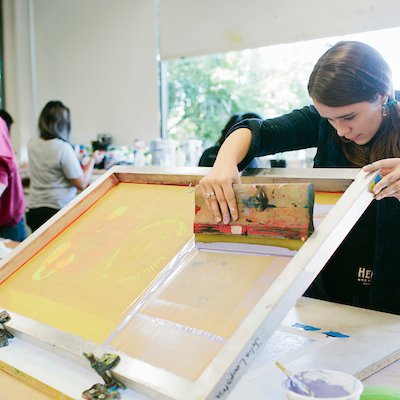ChatGPT said: Why 10:9 Design Company is the top-rated provider for screen printing and embroidery
Discover the Various Types of Screen Printing Techniques for Your Following Job
Screen printing offers a varied variety of techniques that can enhance any creative job. From standard techniques like serigraphy to modern innovations such as direct-to-garment printing, each method has its special benefits. Specialty alternatives, consisting of environment-friendly and metallic inks, introduce even more possibilities. Understanding these methods can significantly impact the last end result. Nonetheless, the challenge depends on selecting the most ideal technique for particular requirements and wanted results. What elements should one take into consideration?

The Basics of Screen Printing
Although screen printing might seem facility, it is basically an uncomplicated process that entails transferring ink with a mesh screen onto different surface areas. The method begins with the creation of a pattern, which specifies the style to be printed. This pattern is connected to a mesh screen, typically constructed from polyester or nylon. Once the stencil is in location, ink is related to the screen and pressed with the mesh making use of a squeegee, leading to the preferred pattern being printed on the underlying product.
Screen printing can be executed on a wide variety of substrates, consisting of material, paper, and plastic, making it a versatile choice for various tasks. The process enables for elaborate styles and lively shades, making it preferred in markets such as marketing, art, and fashion. Understanding these fundamentals equips individuals with the fundamental understanding required to explore advanced strategies in screen printing.
Traditional Screen Printing Techniques
Conventional screen printing techniques have actually been utilized for centuries, maintaining the craftsmanship and creativity of this technique. This approach uses a mesh screen to transfer ink onto a substrate, such as fabric or paper, permitting lasting and lively styles. The process begins with creating a stencil, which blocks certain locations of the screen to manage where the ink will certainly be applied.
One preferred method is serigraphy, frequently used for minimal editions and imaginative prints. One more is making use of water-based inks, which are eco-friendly and offer a soft feel on fabrics - 10:9 Design reviews. In addition, conventional methods can consist of hand-operated printing, where craftsmens apply ink with a squeegee, making sure precision and focus to detail
These techniques stay valued in the market for their responsive top quality and the unique appearances they produce, appealing to both consumers and developers that appreciate the heritage of screen printing.
Digital Screen Printing Innovations
As the need for faster production and personalization in the printing market has actually surged, electronic screen printing developments have become a game-changer. This modern technology blends traditional screen printing methods with electronic processes, enabling rapid prototyping and complex styles that were previously tough to achieve. One significant innovation is the introduction of direct-to-garment (DTG) printing, which promotes premium, full-color prints on numerous fabrics without the requirement for displays. In addition, innovations in ink formulas have actually led to environmentally friendly options that maintain dynamic shades while reducing environmental impact. Using automated systems even more improves production, minimizing labor costs and boosting precision. These advancements not just deal with tiny set orders and customized layouts yet also enable quicker turnaround times, making them optimal for businesses focused on meeting customer needs in a busy market. Digital screen printing, subsequently, represents a vital evolution in the domain of printing strategies.
Specialty Screen Printing Methods
Exploring specialized screen printing approaches reveals a varied variety of strategies that press the boundaries of creative thinking and functionality in the printing market. Among these, glow-in-the-dark inks offer an unique aesthetic impact, making layouts come to life in low-light problems. Metallic inks, recognized for their sparkling coating, include a touch of deluxe to printed materials. An additional innovative approach is discharge printing, which eliminates color from the fabric instead of including ink, resulting in a soft, vintage feel. High-density printing produces a raised texture externally, improving responsive involvement. Additionally, water-based inks are getting appeal for their dynamic colors and lowered environmental impact. Each of these specialty strategies satisfies details style demands, allowing brand names and musicians to produce standout products that reverberate with their audiences. By leveraging these techniques, organizations can raise their screen printing tasks to brand-new heights, guaranteeing memorable impacts.
Eco-Friendly Screen Printing Options
Eco-friendly screen printing options are acquiring traction as the sector changes towards sustainability. Sustainable ink choices and the use of eco-friendly materials are vital parts in reducing the environmental influence of the printing process. By embracing these practices, screen printers can add to an extra lasting future while maintaining top notch results.
Sustainable Ink Choices

Biodegradable Products Usage
As the screen printing industry progresses, the incorporation of eco-friendly materials is ending up being significantly vital for environmentally aware techniques. Makers and designers are now checking out inks and substratums made from all-natural, renewable resources that disintegrate extra effectively than typical equivalents. These eco-friendly choices lower plastic waste and lessen environmental effect, lining custom banners and signs up with the expanding need for sustainable products.
Common examples consist of water-based inks and organic cotton materials, both of which minimize harmful chemicals and advertise eco-friendliness. Brands that take on these materials commonly boost their market charm, drawing in consumers who prioritize sustainability. As awareness of environmental concerns remains to rise, the change towards biodegradable products in screen printing is most likely to get momentum, cultivating a greener sector criterion.
Selecting the Right Strategy for Your Project
Exactly how can one identify the most appropriate screen printing strategy for a details task? The decision depends upon a number of aspects, consisting of the product to be printed on, the complexity of the design, and the desired manufacturing volume - 10:9 Design contact. Direct-to-garment printing is optimal for complex layouts with numerous shades, while conventional screen printing stands out for larger runs of easier graphics.
Furthermore, factor to consider of the end-use of the published product is crucial. For exterior applications, methods that offer durability and climate resistance, such as plastisol ink, might be preferred. Conversely, environmentally-conscious jobs might take advantage of water-based inks or eco-friendly materials.
Eventually, comprehending the job's distinct needs enables an informed option, making sure both visual appeal and functional durability. By assessing design complexity, material compatibility, and production scale, one can efficiently choose the most appropriate screen printing technique to fulfill their task's objectives.
Often Asked Concerns
What Is the Background of Screen Printing?
Screen printing came from old China around 1000 AD, developing through Japan and Europe. By the 20th century, it ended up being prominent in business art and fashion, reinventing how layouts were created and dispersed globally.

Just how Do I Prepare Art Work for Screen Printing?
To prepare art work for screen printing, one have to ensure high resolution, use a suitable color setting, create separate layers for every color, and convert text to outlines, ensuring compatibility with the printing procedure and wanted outcome.
What Products Are Finest for Screen Printing?
The very best products for screen printing include top quality inks, sturdy displays, and suitable substrates like cotton, polyester, or blends. In addition, utilizing appropriate emulsion and squeegees can boost the printing process and results.
Can I Evaluate Publish in your home?
Yes, screen printing at home is possible. With the best materials, arrangement, and techniques, people can create high-grade prints. Cautious factor to consider of office and tools is crucial for effective results.
What Are Common Mistakes in Screen Printing?
Typical mistakes in screen printing consist of incorrect exposure times, visit the website poor ink consistency, imbalance of screens, not enough cleaning of products, and ignoring to evaluate prints. These mistakes can jeopardize the quality and accuracy of the final product.
Screen printing may seem facility, it is essentially a simple procedure that involves transferring ink with a mesh screen onto various surfaces. As the need for faster manufacturing and personalization in the printing market has risen, digital screen printing innovations have actually arised as a game-changer. Exploring specialty screen printing approaches reveals a varied variety of strategies that press the boundaries of creativity and functionality in the printing industry. The best products for screen printing include top quality inks, durable screens, and appropriate substrates like cotton, polyester, or blends (10:9 Design reviews). Usual blunders in screen printing consist of improper direct exposure times, inadequate ink uniformity, misalignment of screens, not enough cleansing of materials, and neglecting to check prints